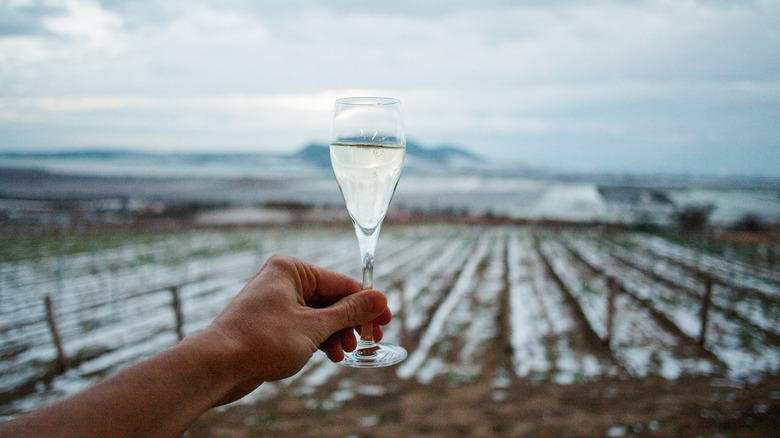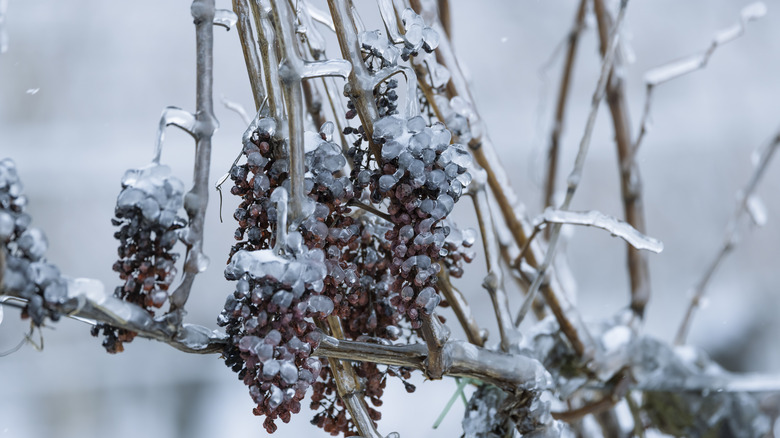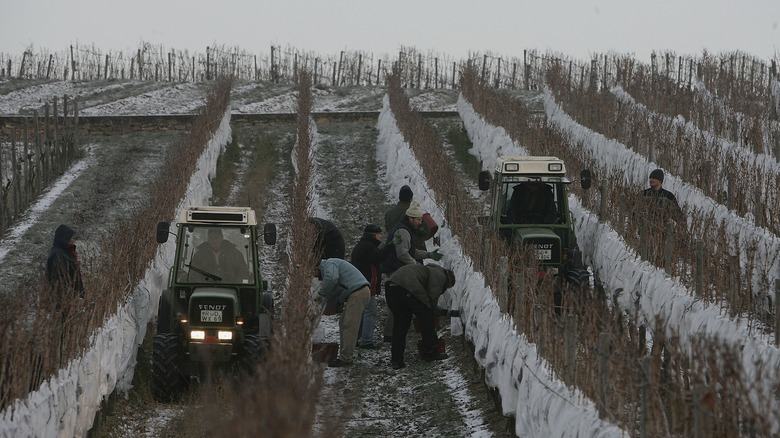Why Michigan's Climate Is Perfect For Producing Ice Wine
What do you think of when you read the term "ice wine?" Perhaps a wine slushie, or (gasp!) a glass of wine with ice cubes in it. But ice wine is simply wine made from frozen grapes — not as in from the frozen aisle, but grapes that froze while still on the vine (per Wine Traveler). Liquor.com reports that wines were originally made this way so farmers could make the most of surprise frosts. Today, ice wine is considered a special, supremely sweet treat — the Ice Queen of dessert wines. As reflected on Total Wine's website, ice wines are offered in a variety of grapes and vintages, and tend to run on the pricey side.
Ice wine production is a touchy process. According to Wine Traveler, it begins when cold temperatures freeze the water inside hanging wine grapes, which may thaw and refreeze several times before harvest — concentrating the sugars and flavorful compounds, which don't freeze. The grapes are picked still-frozen, the precious juice is extracted from the water, and the winemaking begins in earnest with fermentation. Even yeast can't handle all the sugar in ice wine, so the finished product often contains 12% or less alcohol. Liquor.com says ice wine also has a thicker body, almost like syrup.
Ice wine from the Wolverine State
While Canada is famous for ice wine (per Wine Traveler) and Germany is catching up (per Liquor.com), a few American states make it too. One of these is Michigan, where temperatures frequently drop to 18 degrees Fahrenheit — the sweet spot for perfectly frosty grapes. If it's colder than that for prolonged periods, the fruit will be too frozen to work with, Pure Michigan explains. Old Mission Peninsula Wine Trail adds that Michigan has lake effect snow (from cold Canadian air sweeping across the Great Lakes, per the National Weather Service), creating snow drifts that help protect future ice wine grapes from fruit-loving critters as they sweeten on the vine.
Pure Michigan says that in-state as well as worldwide, ice wine can only be called ice wine if it meets certain criteria: The grapes must have been at least partly frozen on the vine, not after harvest (that's "ice-style"), and cannot be thawed at harvest time. Because of this short, specific window, grape picking has to be done by hand, often at the drop of a hat. It's hard to plan around the weather — and even if you expect a cold snap, leaving grapes on the vine for too long is an invitation to animals.
Investing in ice wine
Ice wine production is similar to making maple syrup, whose "sugaring season" occurs when changes between above and below freezing cause sap to flow, per the United States Department of Agriculture. But due to global climate change, it's increasingly difficult for producers to anticipate the right weather conditions. As such, it might be a good idea to buy and reserve a few bottles of ice wine, as it will appreciate in value (per Liquor.com). Let its soothing sweetness alleviate your sticker shock. Fortunately, ice wines age very well — keeping for tens of years. There's also the world of ice cider to explore.
You can buy ice wine at specialty liquor stores or online, but the best way to support viticulturists and winemakers is to purchase from them directly. Pure Michigan suggests visiting several wine trails featuring wineries that produce ice wine. Keep in mind that all the aforementioned factors contribute to ice wine's high price tag. Cooking with ice wine is luxurious — like in The New York Times recipe for salt-baked snapper with ice wine nage. Or you can simply pair it with assertive cheeses, spicy cuisine, briny morsels, and fatty foods like pâté, suggests Niagara Falls Hotels. Between its succulence and rarity, there's never been a better time to try ice wine.


